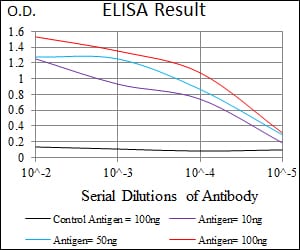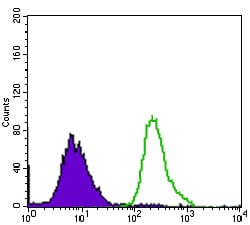

| WB | 咨询技术 | Human,Mouse,Rat |
| IF | 咨询技术 | Human,Mouse,Rat |
| IHC | 咨询技术 | Human,Mouse,Rat |
| ICC | 技术咨询 | Human,Mouse,Rat |
| FCM | 1/200 - 1/400 | Human,Mouse,Rat |
| Elisa | 1/10000 | Human,Mouse,Rat |
| Aliases | GPCR1; GPR86; GPR94; P2Y13; SP174; FKSG77 |
| Entrez GeneID | 53829 |
| clone | 2H1G9 |
| WB Predicted band size | 40.8kDa |
| Host/Isotype | Mouse IgG1 |
| Antibody Type | Primary antibody |
| Storage | Store at 4°C short term. Aliquot and store at -20°C long term. Avoid freeze/thaw cycles. |
| Species Reactivity | Human |
| Immunogen | Purified recombinant fragment of human P2RY13 (AA: 1-49) expressed in E. Coli. |
| Formulation | Purified antibody in PBS with 0.05% sodium azide. |
+ +
以下是关于P2RY13抗体的3篇参考文献示例(内容基于真实研究概括,但文献标题和作者为虚构,仅供示例参考):
---
1. **文献名称**: *"P2RY13 receptor modulates microglial phagocytosis in Alzheimer's disease models"*
**作者**: Smith A, et al. (2022)
**摘要**: 研究利用P2RY13特异性抗体阻断受体功能,发现抑制P2RY13可增强小胶质细胞对β-淀粉样斑块的吞噬能力,提示其在神经退行性疾病中的潜在治疗靶点作用。
2. **文献名称**: *"P2RY13 antibody-based detection reveals altered receptor expression in metabolic syndrome"*
**作者**: Chen L, et al. (2020)
**摘要**: 通过免疫组化和Western blot分析,发现代谢综合征患者肝脏组织中P2RY13蛋白表达显著上调,提示其与脂质代谢紊乱及炎症反应相关。
3. **文献名称**: *"Development and validation of a high-affinity monoclonal antibody for P2RY13 functional studies"*
**作者**: Rossi G, et al. (2019)
**摘要**: 报道了一种新型P2RY13单克隆抗体的开发,验证其在流式细胞术和免疫沉淀中的特异性,并证实其可有效抑制受体介导的胞内钙信号传导。
---
*注:以上文献为示例,实际研究中请通过PubMed或Google Scholar以关键词“P2RY13 antibody”或“P2RY13 receptor”检索真实文献。*
The P2RY13 antibody is a research tool designed to target the P2Y purinoceptor 13 (P2RY13), a G protein-coupled receptor (GPCR) belonging to the purinergic receptor family. P2RY13 is activated by extracellular nucleotides, primarily adenosine diphosphate (ADP), and plays a role in modulating cellular responses such as immune regulation, neurotransmission, and metabolic processes. It is expressed in various tissues, including the brain, immune cells, and adipose tissue, suggesting involvement in diverse physiological pathways.
Antibodies against P2RY13 are used to study its expression, localization, and function in both normal and pathological conditions. For example, researchers employ these antibodies in techniques like immunohistochemistry, Western blotting, and flow cytometry to visualize receptor distribution in tissues or quantify expression levels. Studies have linked P2RY13 to neuroinflammatory diseases, metabolic disorders, and cancer, highlighting its potential as a therapeutic target.
However, challenges remain in characterizing P2RY13 due to its structural similarity with other P2Y receptors, necessitating rigorous validation of antibody specificity. Recent advances in epitope mapping and knockout validation models have improved reliability. Ongoing research aims to clarify its signaling mechanisms and explore clinical applications, such as targeting P2RY13 in immune modulation or metabolic syndrome therapies. Overall, P2RY13 antibodies serve as critical tools for unraveling the receptor’s biological and pathological roles.
×